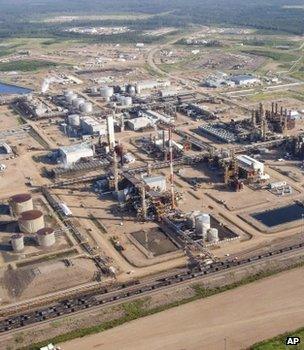Oil sands' toxins 'accumulate in freshwater ecosystems'
- Published

Toxic pollutants released by oil sands mining operations are accumulating in freshwater ecosystems, research by Canadian scientists suggests.
A study of sediment in nearby lakes showed the level of pollutants, known as PAHs, had risen since the 1960s when oil sands development began.
However, the researchers added that PAH concentrations were still lower than those found in urban lakes.
The findings appear in the Proceedings of the National Academy of Sciences.
PAH refers to polycyclic aromatic hydrocarbons - a group of chemicals that have been shown to affect aquatic organisms and birds. PAHs have also been described as being responsible for damaging food crops.
The chemicals occur naturally in coal, crude oil, and petroleum; they are also present in products made from fossil fuels, such as creosote and asphalt.
PAHs also can be released into the air during the burning of fossil fuels and organic matter - the less efficient the burning process, the more PAHs are given off. Forest fires and volcanoes produce PAHs naturally.
Digging the dirt
Using sediment cores from five lakes within a 35km (22-mile) radius of major oil sands facilities and one remote lake (90km/56 miles from the facilities), the researchers assessed the ecological impact of oil sands developments on freshwater ecosystems.
Analysis of the samples showed that PAH levels were now 2.5-23 times greater than levels from about 1960.
In their paper, the team wrote: "PAH ratios indicate temporal shifts from primarily wood combustion to [decomposed organic material] sources that coincide with greater oil sands development.
"Canadian interim sediment quality guidelines have been exceeded since the mid-1980s at the most impacted sites."
Oil sands, also known as tar sands, have only recently considered to be a viable component of the world's oil reserves as a result of rising energy prices and the development of technology that has made its processing profitable.
These factors has resulted in a marked increase in the extraction and processing of oil sands in northern Alberta and Saskatchewan, which account for 97% of the nation's proven reserves and is the world's third largest reserve.
The researchers say that in 1980, daily production was 100,000 but has grown to about 1.5 million barrels a day, It is projected to reach 3.7 million barrels by 2025, they added.
Sticky situation
The development of the oil sands sector has been controversial, prompting polemic between those in favour of utilising the resource to cushion the Canadian economy from shocks in global energy prices and those who say the environmental costs are too high.
In 2010, The Star newspaper reported that concerned residents on the shores of Lake Athabasca (downstream from one of the region's major oil sands facilities) had called for the federal government to commission an independent study to assess the impact on the area's water bodies.
The call came after local people said a growing number of landed fish where showing signs of deformities.
They voiced concern that there was not an effective system of environmental monitoring was in place.
At the time, the federal environment minister said he was listening to calls for a monitoring programme.
The researchers behind the PNAS study said that there was conflicting findings among the few long-term PAH datasets that existed, with some suggesting increases in limited areas, while other recording no increase between the 1950s and 1998.
"Establishment of background PAH concentrations and historic loadings is essential and would allow the impacts of development, including industrial PAH contributions, to be compared with the natural range... in lake sediment from the region," they wrote.
"As noted repeatedly in previous assessments of the impacts of the Alberta oil sands operations, insufficient monitoring data and a poor understanding of pre-development conditions have attempts to determine the scope of pollution from oil sands development."
Muddy waters
The team concluded that the findings from their study had to be considered in a wider environmental context.
"As a consequence of climate warming, the physical processes that lakes experience can be altered," they said.
"Longer ice-free season and enhanced thermal stability, coupled with higher surface-water temperatures and the redistribution of nutrients within the water column, contribute to greater algal production within many lake ecosystems."
They concluded: "Analyses of sediment cores from five lakes near major oil sands operations and remote Namur Lake demonstrate that modern PAH concentrations and fluxes, including DBTs, are well above 'natural' pre-development levels."
But, they added: "The ultimate ecological consequences of decades-long increases in aquatic primary production, coupled with greater PAH loadings to lakes in the oil sands region, are unknown and require further assessment."
Adam Sweet, press secretary for Canada's Environment Minister Peter Kent, said the Joint Canada-Alberta Implementation Plan for Oil Sands Monitoring, announced in February 2012, was committed to a "scientifically rigorous, comprehensive, integrated, and transparent environmental monitoring program for the region.
"It is important to note that the results in this paper come from field studies that were conducted prior to the announcement of the Joint Plan," he told BBC News.
"In fact, the Joint Plan was created, and implemented, to address the very concerns raised by such studies - it was designed to provide an improved understanding of the long-term cumulative effects of oil sands development.
"Canada has strong rules and regulations in place to ensure that the Canadian environment is protected, and our government will continue to ensure that Canada's oil sands are developed responsibly."
- Published21 February 2012
- Published4 February 2012
- Published29 November 2011
- Published1 May 2011